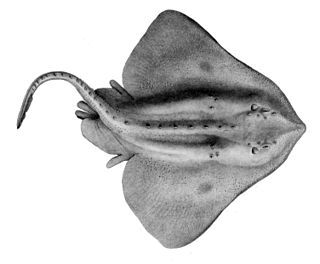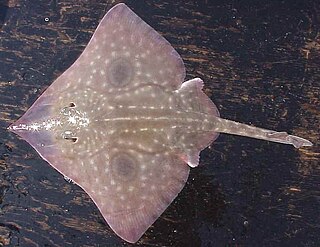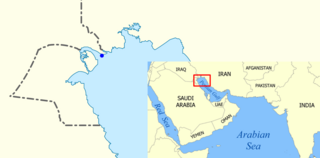
Skates are cartilaginous fish belonging to the family Rajidae in the superorder Batoidea of rays. More than 150 species have been described, in 17 genera. Softnose skates and pygmy skates were previously treated as subfamilies of Rajidae, but are now considered as distinct families. Alternatively, the name "skate" is used to refer to the entire order of Rajiformes.

Rajiformes is one of the four orders in the clade Batomorphi, often referred to as the superorder Batoidea, flattened cartilaginous fishes related to sharks. Rajiforms are distinguished by the presence of greatly enlarged pectoral fins, which reach as far forward as the sides of the head, with a generally flattened body. The undulatory pectoral fin motion diagnostic to this taxon is known as rajiform locomotion. The eyes and spiracles are located on the upper surface of the head and the gill slits are on the underside of the body. Most species give birth to live young, although some lay eggs enclosed in a horny capsule.

Raja, also known as raia, is a genus of skates in the family Rajidae containing 16 species. Formerly a wastebasket genus, many species historically categorized here have been moved to other genera in the family, such as Amblyraja, Beringraja, Dipturus, Leucoraja and Rostroraja. Raja are flat-bodied, cartilaginous fish with a rhombic shapes due to their large pectoral fins extending from or near from the snouts to the bases of their tails. Their sharp snouts are produced by a cranial projection of rostral cartilage. The mouth and gills are located on the underside of the body. They may be either solid-coloured or patterned, and most skates have spiny or thorn-like structures on the upper surface, while some species contain weak electrical organs within their tails. Mating typically occurs in the spring and the female lays numerous eggs per clutch which are encapsulated in leathery cases, commonly known as "mermaid’s purses". Species vary in size, ranging from about 40 to 140 cm (1.3–4.6 ft) in length. These bottom-dwellers are active during both day and night, and typically feed on molluscs, crustaceans and fish. Raja skates are found in the East Atlantic, also in the Mediterranean, and western Indian Ocean, ranging from relatively shallow water to a depth of 800 m (2,600 ft). Skates and related species have fossil records dating from the Upper Cretaceous period, thus this well-adapted species is quite ancient.

The barndoor skate is a species of marine cartilaginous fish in the skate family Rajidae of the order Rajiformes. It is native to the northwestern Atlantic Ocean, and is found from the Grand Banks of Newfoundland and the southern side of the Gulf of St. Lawrence south to North Carolina. The fish is one of the largest skates found in the North Atlantic Ocean, reaching lengths up to 1.5 m (5 ft). It is carnivorous, feeding on invertebrates and other fish found near the sea floor.
The Maugean skate or Port Davey skate is an endangered species of fish in the family Rajidae. It is endemic to Tasmania, only found in the brackish estuarine waters of Macquarie Harbour and Bathurst Harbour. The species was discovered in 1988 by Dr Graham Edgar. It was named in honour of René Maugé, a zoologist on the Baudin expedition to Australia, who died in Tasmania in 1802.

The thornback ray, or thornback skate, is a species of ray fish in the family Rajidae.

The big skate is the largest species of skate in the waters off North America. They are found along the Pacific Coast from Alaska to Baja California, typically from the intertidal zone to a depth of 120 m (390 ft), and feed on benthic invertebrates and small fishes. They are unusual among skates in that their egg cases may contain up to seven eggs each. This species is one of the most commercially important skates off California and is sold for food.

The broad skate is a poorly known species of skate in the family Rajidae. It occurs at depths of 846 to 2,324 metres, and has been observed via remotely operated underwater vehicle by the Monterey Bay Aquarium Research Institute as deep as 3,167 metres (10,390 ft), making it one of the deepest-occurring skates known. It is sporadically distributed in the Pacific Ocean, from the Gulf of Panama to British Columbia and the Bering Sea, to the Tohoku Slope off northern Honshu and the Okhotsk Slope off Hokkaido. The species name, badia, comes from the Latin batius meaning "brown", referring to its color.

Bathyraja mariposa, sometimes referred to as the butterfly skate, is a species of skate found in the Aleutian islands. It is overall a medium-brown color, lacks thorns on the disc and has indistinct thorns on the tail. It was discovered in 2002 during a National Marine Fisheries Service survey, and first described in 2004. The holotype specimen is held at the University of Washington. Its species name "mariposa" derives from the Spanish word for butterfly, although several other species are sometimes referred to as the "butterfly skate."

The little skate is a species of skate in the family Rajidae, found from Nova Scotia to North Carolina on sand or gravel habitats. They are one of the dominant members of the demersal fish community in the northwestern Atlantic. This species is of minimal commercial importance and is mostly used as bait for lobster traps, though its wings are also marketed for food. It is also important as a model organism for biological and medical research.

The mottled skate is a species of skate in the family Rajidae. An inhabitant of shallow coastal waters, it is found in the northwestern Pacific Ocean off Korea, Japan, and China. This species grows to 1.12 m (3.7 ft) long and has a diamond-shaped pectoral fin disc with a long snout. It is characterized by a covering of prickles above and below its snout, but not elsewhere on its body, and a dark ring in the middle of each "wing".

Black kokanee, or kunimasu in Japanese, is a species of landlocked Pacific trout in Japan that was thought to be extinct for 70 years before being rediscovered in 2010. The species was originally endemic to Lake Tazawa, Akita Prefecture, but was translocated to Lake Saiko in an attempt to save the species. These efforts were only discovered to have been successful in 2010 when nine specimens were captured by a team of researchers including a celebrity biologist, 'Sakana-kun'.
Jensen's skate, also known as the shortail skate, is a poorly known species of fish discovered in 2004 during a study of bottom ichthyofauna aboard the Norwegian RV G.O. Sars, where four species were identified, including A. jenseni.

The clearnose skate is a species of cartilaginous fish in the family Rajidae. R. eglanteria is also known by other common names such as the brier skate and summer skate. Clearnose skates are easily identified by the translucent patches on either side of their snouts and their mottled dorsal surface. They are found along the Atlantic and Gulf coasts of the United States in shallow waters of the continental shelf.

The pita skate is a medium-sized skate in the family Rajidae. The holotype and only known specimen was found in the northern Persian Gulf, in Iraqi waters. It was collected at a depth of less than 15 m (49 ft).

The roundel skate or Texas clearnose skate is a species of cartilaginous fish in the family Rajidae. It is found in the Gulf of Mexico, Southeast Florida and the Yucatan Peninsula.

Caliraja stellulata, commonly known as the Pacific starry skate, rock skate, prickly skate, or starry skate, is a species of cartilaginous fish in the family Rajidae. It is found on rocky bottoms at 18–982 m depths in the Northeast and Eastern Central Pacific, from Coronado Bank in northern Baja California in Mexico to Barkley Sound in British Columbia, Canada. Females reach a maximum total length of 76.1 cm and a maximum age of 15 years, while males can be up to 71.7 cm long and live up to 14 years; the total length at birth is 15.5–22.5 cm. This skate prefers cold water with a temperature of 4.1–11.6°C.

The rough ray is a Mediterranean ray species of the Rajidae family described by Delaroche in 1809.

The Hawaiian chub, also known as the insular rudderfish or bicolor chub, is a species of marine ray-finned fish, a sea chub belonging to the family Kyphosidae. This species is found in the Central Pacific Ocean.
Okamejei panayensis is a demersal fish belonging to the skate family, occurring in nearshore temperate environments and deep-water tropical and boreal regions.
















